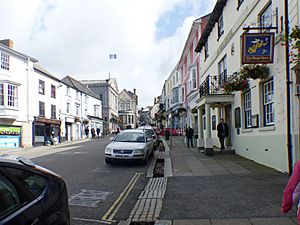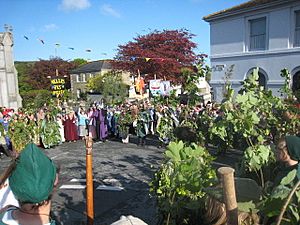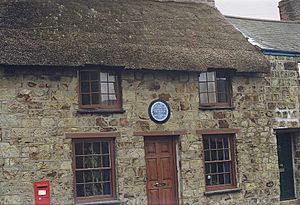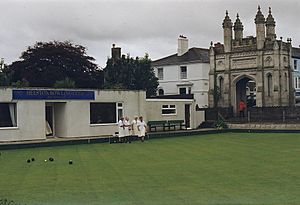Helston facts for kids
Quick facts for kids Helston
|
|
|---|---|
 Coinagehall Street is the main street of Helston. The Guildhall flies a flag |
|
| Lua error in Module:Location_map at line 530: Unable to find the specified location map definition: "Module:Location map/data/Cornwall (mainland)" does not exist. | |
| Population | 11,546 (2011) |
| OS grid reference | SW664273 |
| Civil parish |
|
| Unitary authority | |
| Ceremonial county | |
| Region | |
| Country | England |
| Sovereign state | United Kingdom |
| Post town | HELSTON |
| Postcode district | TR12, TR13 |
| Dialling code | 01326 |
| Police | Devon and Cornwall |
| Fire | Cornwall |
| Ambulance | South Western |
| EU Parliament | South West England |
| UK Parliament |
|
Helston (in Cornish: Hellys) is a lovely town and parish in Cornwall, England. It's located at the northern end of the Lizard Peninsula. The town is about 12 miles (19 km) east of Penzance and 9 miles (14 km) south-west of Falmouth. Helston is the most southerly town on the island of Great Britain. In 2011, about 11,700 people lived here.
Helston used to be a very important town for tin mining and cattle markets. Today, it's most famous for its yearly Furry Dance, also known as the Flora Dance. This special event is thought to have started way back in the Middle Ages. Another part of the celebration, called the Hal-an-Tow, might even come from ancient Celtic mythology. The popular song, The Floral Dance, was written in 1911. In 2001, the town celebrated 800 years since it received its official Charter.
Contents
Discovering Helston's Past
The name Helston comes from the Cornish words 'hen lis' (meaning 'old court') and the Saxon word 'ton' (for 'manor'). So, it means 'old court manor'. The Domesday Book, a famous old survey, called it Henliston.
When Did Helston Get Its Royal Charter?
Helston received its official charter from King John on April 15, 1201. This important document cost the town forty marks of silver. The charter allowed Helston to become a special stannary town. This meant it was one of the places where tin was weighed to figure out how much tax was owed to the Duke of Cornwall.
What About Helston Castle?
Helston once had a castle! It was a simple motte and bailey castle, built before 1086. This type of castle had a mound (motte) with a tower and a walled courtyard (bailey). In 1280, a stone castle was built in its place for Edmund, 2nd Earl of Cornwall. By 1478, the castle was no longer used and became a ruin. Today, a bowling green is on the site where the castle used to stand.
Exploring Helston's Location
Helston is built along the banks of the River Cober in Cornwall. Downstream from the town, you'll find Cornwall's largest natural lake, Loe Pool. This lake formed when a shingle bar, made of small stones, blocked the river's mouth. This happened because sea levels rose after the last ice age. South of Helston is the beautiful Lizard Peninsula, an area known for its unique rocks and amazing wildlife.
How to Get Around Helston?
Helston is connected by the A394 road. If you go west, the A394 leads to Penzance. If you head north-east, it takes you to Penryn, where it joins the A39. The A39 then goes south to Falmouth and north-east to Truro. The B3297 road goes north from Helston to Redruth.
The closest train station is Redruth, which is on the main Cornish railway line. Helston used to have its own train line, the Helston branch line, but it closed in the early 1960s. Now, the Helston Railway Preservation Company is working to bring part of it back! You can catch a bus from Helston to connect to the train network.
The nearest airport is Newquay Cornwall Airport, about 35 miles (56 km) north-east of Helston. This airport has regular flights to many parts of the UK.
What's the Weather Like in Helston?
Helston has an oceanic climate, which means it has mild winters and cool summers, similar to the rest of the British Isles. It's one of the mildest places in the UK, so severe frosts are rare. The closest official weather station is at RNAS Culdrose, just a mile south-east of the town.
Since 1980, temperatures have ranged from a very cold -10.9°C (12.4°F) in January 1987 to a warm 29.6°C (85.3°F) in August 1990. Snow doesn't happen often, usually every other year for a few days in January or February.
| Climate data for Helston airport, 1996–2017 normals | |||||||||||||
|---|---|---|---|---|---|---|---|---|---|---|---|---|---|
| Month | Jan | Feb | Mar | Apr | May | Jun | Jul | Aug | Sep | Oct | Nov | Dec | Year |
| Record high °F (°C) | 58 (14) |
57 (14) |
66 (19) |
66 (19) |
73 (23) |
71 (22) |
81 (27) |
78 (26) |
73 (23) |
73 (23) |
60 (16) |
58 (14) |
81 (27) |
| Mean maximum °F (°C) | 52 (11) |
52 (11) |
54 (12) |
55 (13) |
61 (16) |
68 (20) |
73 (23) |
70 (21) |
68 (20) |
64 (18) |
57 (14) |
54 (12) |
73 (23) |
| Mean daily maximum °F (°C) | 47 (8) |
47 (8) |
49 (9) |
52 (11) |
56 (13) |
60 (16) |
63 (17) |
65 (18) |
63 (17) |
57 (14) |
51 (11) |
48 (9) |
55 (13) |
| Mean daily minimum °F (°C) | 40 (4) |
39 (4) |
40 (4) |
42 (6) |
47 (8) |
50 (10) |
54 (12) |
55 (13) |
52 (11) |
49 (9) |
43 (6) |
40 (4) |
48 (9) |
| Mean minimum °F (°C) | 28 (−2) |
26 (−3) |
30 (−1) |
33 (1) |
37 (3) |
46 (8) |
50 (10) |
47 (8) |
45 (7) |
41 (5) |
32 (0) |
28 (−2) |
26 (−3) |
| Record low °F (°C) | 19 (−7) |
23 (−5) |
26 (−3) |
26 (−3) |
36 (2) |
46 (8) |
41 (5) |
43 (6) |
41 (5) |
32 (0) |
21 (−6) |
23 (−5) |
19 (−7) |
| Average rainfall inches (mm) | 4.465 (113.4) |
3.165 (80.4) |
3.157 (80.2) |
2.646 (67.2) |
2.362 (60.0) |
2.382 (60.5) |
2.433 (61.8) |
2.638 (67.0) |
2.831 (71.9) |
4.134 (105.0) |
4.555 (115.7) |
4.563 (115.9) |
39.331 (999) |
| Average rainy days (≥ 39.323 in) | 16.5 | 12.4 | 13.0 | 11.6 | 9.9 | 8.7 | 10.0 | 10.7 | 10.2 | 15.2 | 15.8 | 16.2 | 150.2 |
| Mean monthly sunshine hours | 56.6 | 79.7 | 109.7 | 177.8 | 205.9 | 202.7 | 197.2 | 192.0 | 150.4 | 105.7 | 76.3 | 54.2 | 1,608.2 |
| Source 1: Wunderground | |||||||||||||
| Source 2: MeteoFrance | |||||||||||||
Helston's Fun Culture and Community
Helston is famous for its lively traditions and community spirit.
What is Flora Day?
Flora Day is a huge annual celebration in Helston! It happens on May 8th, unless that day is a Sunday or a Monday (which used to be market day). If so, it moves to the Saturday before. The main event is the Furry Dance.
There are four dances throughout the day:
- The first dance starts at 7 a.m. and used to be for people who worked in homes. Dancers wear white shirts and dark trousers.
- At 9:50 a.m., children from the town's schools dance. They all wear white, and their different schools are shown by the special head dresses the girls wear.
- The main dance, called the "premier dance," is at midday. This is for the town's important people. Ladies wear long ballgowns and fancy hats, while gentlemen wear formal morning suits.
- The last dance begins at 5 p.m. This one was traditionally for the town's shopkeepers and tradespeople. These dancers are the only ones who dance around the town twice!
Only people born in Helston can lead the dances. The Helston Town Band plays the famous tune for all four dances as they wind through the town. Homes and shops are decorated with bluebells, campions, and other green plants. The dancers even go in and out of some private buildings and shops! The dance's exact beginnings are a mystery, but it seems to be an old celebration of winter ending and spring arriving.
What is Hal-an-Tow?
On the same day as Flora Day, another fun event called "Hal an Tow" takes place. This is a morning ritual that's a bit more energetic than the dance. It's like a moving street play that probably started in the Middle Ages. The themes are often more English than just Cornish. The Hal-an-Tow involves singing, dancing, and acting out the song's story. The costumes and song represent different historical and mythical ideas. It changes over time; for example, a new verse about St Piran was added in the 21st century.
Helston's Music Scene: Guitar Festival and Town Band
In 2017, the Hellys International Guitar Festival began. It brings famous guitar players from all over the world to Helston every August. They perform concerts and even give free lessons!
The Helston Town Band has a long and proud history, going back to the early 1900s. Many families have been part of the band for generations! The band has won many awards and competitions over the years. They even reached the top "Championship Section" in 2009, which was a first for them!
Important Buildings and Places to Visit
Helston has several interesting churches and places to explore.
What Churches Can You See in Helston?
One important church is St Michael's Church. It's a simple church with beautiful stained-glass windows and a tall bell tower. You can hear its bells ringing throughout the town. In the churchyard, there's a monument to Henry Trengrouse. He invented the rocket-fired safety line, a clever device used to save lives from shipwrecks.
Where Was Bob Fitzsimmons Born?
Helston is the birthplace of Bob "Ruby Robert" Fitzsimmons, a famous boxer. He was the first person to win three world boxing championships! The house where he was born and lived in Helston is still there, and a special plaque marks it.
What Can You See at Helston Museum?
The Helston Museum, opened in 1949, is in a building that used to be the town's market house in 1837. It had separate areas for butter and eggs, and for meat. The museum's exhibits mostly show Helston's history as a farming and market town. It also hosts art shows and has a shop selling Cornish items.
Other Interesting Spots in Helston
You can find three old Cornish crosses in Helston. One is on Cross Street, and two are in Mr. Baddeley's garden. These crosses are very old and have interesting designs.
The Grylls Monument, at the end of Coinagehall Street, was built in 1834. It honors Humphry Millet Grylls, a local banker. He helped save Wheal Vor, a local mine that employed over a thousand people, from closing down.
Helston is also home to The Flambards Experience, a theme park with rides and some aviation exhibits. Nearby, Poldark Mine is a theme park where you can go underground into old mine tunnels. The Helston Railway, which is being restored, is also close by.
Schools in Helston
Helston Community College has the most students in Cornwall. Its South Site building used to be Helston Grammar School from 1939 to 1972. The grammar school itself has a long history, going back to the 16th century. Famous people like Charles Kingsley and Henry Trengrouse (the inventor) were once students there.
Helston has three primary schools: Parc Eglos, St. Michael's, and Nansloe. There's also a primary school in nearby Trannack. All three primary schools and Helston Community College take part in the Flora Day dance!
Helston in the News
Local TV news for Helston comes from BBC South West and ITV West Country. You can also listen to local radio stations like BBC Radio Cornwall, Heart West, Greatest Hits Radio South West, Pirate FM, and Coast FM. The town has local newspapers too, including The West Briton and The Packet.
Sports and Fun Activities in Helston
Helston has a very active sports scene!
What Sports Can You Play in Helston?
The town has a rugby club, Helston RFC, a football club, Helston Athletic FC, and a cricket club. Rugby has been played in Helston since at least 1883! The Swallows Gymnastics Club is also very popular. Helston hosts an annual road race called An Resek Helys (The Race for Helston) and a yearly triathlon.
Where Can You Relax and Play?
Helston has a King George V Playing Field, which is where the rugby club plays and where the An Resek Helys race finishes. Below the town is Coronation Park, which has a man-made lake where you can rent rowing boats in the summer. There's also a skate park nearby.
Across the road from Coronation Park is the Penrose Amenity Area. This area, owned by the National Trust, offers lovely walks along the River Cober. The river leads down to Loe Pool and the sea. You can even find a bird-watching hide there to watch birds on Loe Pool!
Cornish Wrestling in Helston
Helston has been a big center for Cornish wrestling for hundreds of years. Many tournaments have been held in different places around the town, including Helston Downs, Coronation Park, and the Penrose Amenity Area.
Helston's Twin Towns
Helston is twinned with two other towns:
- Sasso Marconi, in Bologna, Italy
- Plougasnou, in Brittany, France
Images for kids
-
The birthplace of Bob Fitzsimmons
See also
 In Spanish: Helston para niños
In Spanish: Helston para niños










